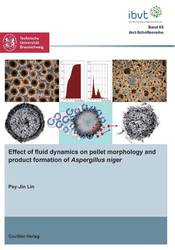| Departments | |
|---|---|
| Book Series (96) |
1378
|
| Nachhaltigkeit |
3
|
| Gesundheitswesen |
1
|
| Humanities |
2364
|
| Natural Sciences |
5406
|
| Mathematics | 229 |
| Informatics | 319 |
| Physics | 980 |
| Chemistry | 1363 |
| Geosciences | 131 |
| Human medicine | 243 |
| Stomatology | 10 |
| Veterinary medicine | 108 |
| Pharmacy | 147 |
| Biology | 835 |
| Biochemistry, molecular biology, gene technology | 121 |
| Biophysics | 25 |
| Domestic and nutritional science | 45 |
| Agricultural science | 1004 |
| Forest science | 201 |
| Horticultural science | 20 |
| Environmental research, ecology and landscape conservation | 148 |
| Engineering |
1793
|
| Common |
98
|
|
Leitlinien Unfallchirurgie
5. Auflage bestellen |
|
Advanced Search
Effect of fluid dynamics on pellet morphology and product formation of "Aspergillus niger" (Volume 65) (English shop)
Pey-Jin Lin (Author)Preview
Extract, PDF (210 KB)
Table of Contents, PDF (66 KB)
The product formation of the biopellets of filamentous fungi, such as Aspergillus niger, is closely linked with the pellet morphology. Therefore, investigations were carried out to determine the influence of fluid dynamic conditions on the growth of fungal pellets. During the present study, important information about the evolution of morphological changes during the cultivation process in stirred tank reactors was gathered from cultivations at different volumetric power inputs by agitation and aeration. The quantification of the pellet morphology was accomplished by the digital image analysis and the laser diffraction technique tracing parameters like the pellet diameter and the pellet concentration. The property of the pellet surface structure was determined by the microscopic image analysis of the pellet slices and verified by sedimentation velocity measurements. Results revealed a notable variation in morphological data among pellets cultivated at different volumetric power inputs by agitation and aeration, by which the production yields of the model product glucoamylase were correspondingly altered. Furthermore, without raising the total energy input, by utilizing of the different impact of aeration- and agitation-induced volumetric power input on the fungal pellet morphology, the product formation could be consequentially improved.
Die Produktbildung der Biopellets von filamentösen Pilzen, wie Aspergillus niger, ist eng mit der Pelletmorphologie verknüpft. Daher wurden Untersuchungen durchgeführt, um den Einfluss von fluiddynamischen Bedingungen auf das Wachstum von Pilzpellets zu bestimmen. In der vorliegenden Arbeit wurden wichtige Informationen über die Entwicklung der morphologischen Veränderungen von Kultivierungen bei verschiedenen Leistungseinträgen durch Rühren und Begasen gesammelt. Die Quantifizierung der Pelletmorphologie wurde, zur Erfassung verschiedener Parameter wie zum Beispiel des Pelletdurchmessers oder der Pelletkonzentration, mit Hilfe von Bildanalyse und Laserbeugung durchgeführt. Die Qualifizierung der Pelletoberflächenstruktur wurde durch die mikroskopische Bildanalyse von Pelletschnitten bestimmt und durch Sinkgeschwindigkeitsmessungen verifiziert. Die Ergebnisse zeigten eine bemerkenswerte Variation in morphologischen Daten bei Pellets, die unter verschiedenen Leistungseinträgen durch Rühren und Begasen kultiviert wurden, wodurch sich die Ausbeuten des Modellprodukts Glucoamylase entsprechend veränderten. Weiterhin konnte ohne Erhöhung des Gesamtenergieeintrags bei Variation des begasungs- und rührerinduzierten Leistungseintrags die Pelletmorphologie verändert und die Produktbildung verbessert werden.
| ISBN-13 (Hard Copy) | 9783954041817 |
| ISBN-13 (eBook) | 9783736941816 |
| Final Book Format | A5 |
| Language | English |
| Page Number | 126 |
| Lamination of Cover | matt |
| Edition | 1. Aufl. |
| Book Series | Schriftenreihe des Institutes für Bioverfahrenstechnik der Technischen Universität Braunschweig |
| Volume | 65 |
| Publication Place | Göttingen |
| Place of Dissertation | Braunschweig |
| Publication Date | 2012-08-13 |
| General Categorization | Dissertation |
| Departments |
Biology
Mechanical and process engineering |
| Keywords | Filamentous fungi, Aspergillus niger, fluid dynamics, agitation, aeration, power input, pellet morphology (pellet size, pellet concentration, pellet internal structure, pellet surface structure), digital image analysis, laser diffraction, microscopic image analysis of the pellet slices, sedimentation velocity, kLa, product formation, glucoamylase filamentöser Pilz, Aspergillus niger, Fluiddynamik, Rühren, Begasen, Leistungseintrag, Pelletmorphologie (Pelletgröße, Pelletkonzentration, Pelletinnenstruktur, Pelletoberflächenstruktur), Bildanalyse, Laserbeugung, mikroskopische Bildanalyse von Pelletschnitten, Sinkgeschwindigkeit, kLa, Produktbildung, Glucoamylase |








